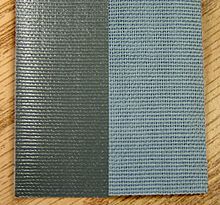Buckram
| Buckram | |
|---|---|
 Buckram can be shiny or dull. | |
| Material type | Cloth |

Buckram is a stiff cotton, or occasionally, linen or horse hair cloth with a plain, usually loose, weave, produced in various weights similar to muslin and other plain weave fabrics.[1] The fabric is soaked in a sizing agent such as wheat-starch paste, glue (such as PVA glue), or pyroxylin (gelatinized nitrocellulose, developed around 1910), then dried. When rewetted or warmed, it can be shaped to create durable firm fabric for book covers, hats, and elements of clothing.[2]
Etymology
In the Middle Ages, "bokeram" simply designated a fine cotton cloth. The etymology of the term remains uncertain; the Oxford English Dictionary considers the commonly mentioned derivation from the name of the city of Bokhara unlikely.[3][4]
Use in bookbinding
Several of buckram's qualities make it attractive for bookbinding. Highly durable, buckram does not allow the bookbinder's paste to seep through and discolor or stain the book's front and back covers.[5]
Pyroxylin-impregnated buckram is often favored due to its resistance to water, insects, fungi, and general wear. This is especially important for library binding, where many people will be repeatedly handling the same books.[6] However, pyroxylin fabrics are less chemically stable than starch-filled fabrics and can be affected by extreme temperatures.[7]
Use in millinery
Millinery buckram is impregnated with a starch which allows it to be softened in water, pulled over a hat block, and left to dry into a hard shape.[8] Millinery buckram comes in many weights, including lightweight or baby buckram (often used for children's and dolls' hats),[9] single-ply buckram, and double buckram (also known as theatrical buckram or crown buckram).[10]
References
- ^ Marks, Stephen S., ed. (1959). ""Buckram"; "Library buckram"; "Muslin". Fairchild's dictionary of textiles. New York: Fairchild Publications. pp. 87, 320, 368.
- ^ Arnold, Janet. Queen Elizabeth's Wardrobe Unlock'd. p. 151.
- ^ An example of the "Bokhara" etymology:
- King, Donald (1987). "Embroidery and Textiles". In Jonathan Alexander; Paul Binski (eds.). Age of Chivalry: Art in Plantagenet England, 1200–1400. London: Royal Academy of Arts; Weidenfeld & Nicolson. pp. 157–161. ISBN 9780297791904. OCLC 1223895666. p. 157:
Fine cotton cloth known as bokeram (derived from Bokhara; the cloth was originally imported from Asia) was used for garments, linings and banners.
- King, Donald (1987). "Embroidery and Textiles". In Jonathan Alexander; Paul Binski (eds.). Age of Chivalry: Art in Plantagenet England, 1200–1400. London: Royal Academy of Arts; Weidenfeld & Nicolson. pp. 157–161. ISBN 9780297791904. OCLC 1223895666. p. 157:
- ^ "buckram". Oxford English Dictionary (Online ed.). Oxford University Press.
Of the ultimate etymology nothing is really known. Some refer to Italian bucherare 'to pierce full of holes', supposing that the name was first given to a kind of muslin or net ... Reiske (in Constantin. Porphyrog. ed. Niebuhr II. 530) proposes Arabic abū qirām 'pannus cum intextis figuris', but he does not say where he found this compound; the simple qirām is of doubtful meaning, the Arab lexicographers quoted in the Qāmūs giving the various renderings 'red veil', 'striped and figured woollen cloth', 'thin veil' ... Others suggest derivation Bokhara, or Bulgaria, but this does not agree with the early French forms.
(Subscription or participating institution membership required.) - ^ Thomson, Paul (8 November 2013). "Introduction to Bookbinding Supplies and Materials". iBookBinding - Bookbinding Tutorials & Resources. Retrieved 8 October 2019.
- ^ "Bookbinding and the Conservation of Books - A Dictionary of Descriptive Terminology". cool.culturalheritage.org. Archived from the original on 2020-07-24. Retrieved 2020-10-17.
- ^ "Books and Bound Items - Preservation Self-Assessment Program". psap.library.illinois.edu. Retrieved 2023-12-06.
- ^ Hart, Eric (2013). The Prop Building Guidebook: For Theatre, Film, and TV. Taylor & Francis. p. 292. ISBN 9780240821382.
- ^ "The Copyist". The Illustrated Milliner. 14 (7). The Illustrated Milliner Company: 68. July 1913. Retrieved 8 October 2019.
- ^ McMasters, Lynn (1 November 2005). "Buckram 101". Finery. Greater Bay Area Costumers Guild. Retrieved 8 October 2019.
External links
- US patent US1712991A, Method for preparing buckram
